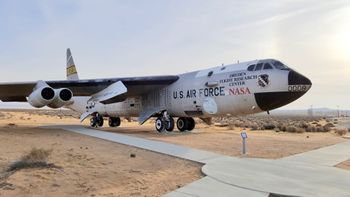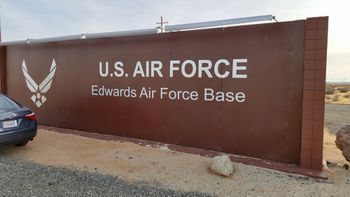Edwards Air Force Base
|
Edwards Air Force Base (1942-Active) - A United States Air Force Base first established in 1942 as Murdoc Army Air Field on the site of the Muroc Bombing and Gunnery Range in Kern County, California. Renamed Muroc Air Force Base circa 1947 when the U.S. Air Force became a separate service. Renamed Edwards Air Force Base on 5 Dec 1949 after Captain Glen W. Edwards, who was killed on 5 Jun 1948 in the crash of an experimental YB-49 jet Flying Wing. Active U.S. Air Force base and NASA Research Center. Location(Text adapted from USAF Fact Sheet) Edwards Air Force Base is Located in Kern County, California, adjacent to the extremely flat, smooth and concrete-like Rogers Dry Lakebed that spreads out over 44 square miles. The smooth lakebed is renewed each year by the winter rains and wind. It provides an ideal surface for the testing of experimental aircraft. Pre World War IIIn September 1933, the Muroc Bombing and Gunnery Range was established by Lt. Colonel H. H. "Hap" Arnold, (Cullum 4596). This remote training site, now a small area within present-day Edwards, served the Army Air Corps bombers and fighters for several years until World War II brought a new role. World War IIDuring World War II, a permanent base was established for the training of combat flight crews. In July 1942, it was activated as a separate post and designated Muroc Army Air Base. The base trained fighter and bomber air crews throughout the war. A separate site, alongside the north shore of Rogers Dry Lakebed, about six miles away from the training base at Muroc was established in the spring of 1942 to test the first U.S. jet aircraft. On 1 Oct 1942, Bell test pilot Bob Stanley lifted the wheels of the Bell XP-59A Airacomet off the dry lakebed. The second U.S. jet aircraft, the Lockheed XP-80 Shooting Star, arrived at the test site soon after. Post World War IIDuring the postwar years, all of America's first generation of jets underwent testing at Muroc, and the great lakebed saved countless pilots in distress. The success of these programs attracted a new type of research activity to the base in late 1946. The rocket-powered Bell X-1 was the first in a long series of experimental aircraft. On 14 Oct 1947, Captain Charles E. "Chuck" Yeager flew the X-1 to become the first human to exceed the speed of sound. The success of that program was followed by other highly experimental research programs including the X-3, X-4, X-5 and XF-92A. The great bulk of flight testing at Edwards focused on the capabilities of aircraft and systems proposed for the operational inventory. Edwards became the center of American flight research when it became the U.S. Air Force Flight Test Center (AFFTC) on 25 Jun 1951 and the U.S. Air Force Test Pilot School moved to Edwards from Wright Field, Ohio. Cold WarThe Cold war era saw the testing of tactical aircraft and interceptors at Edwards AFB. Aircraft tested at Edwards included the famed "Century Series" of fighters:
Space FlightOne major component of the Cold War Era was the Space Race and it had a major impact on Edwards. The Test Pilot School was re-designated the Aerospace Research Pilot School as it began training future military astronauts. In July 1962, the X-15 became the first airplane to fly in near space as it soared above 314,000 feet, winning astronaut wings for its pilot, Major Robert M. White. On 3 Oct 1967 Major William J. "Pete" Knight in the highly modified X-15A-2 reached a record top speed of Mach 6.72 (4,520 mph). Test pilots at Edwards continued to test jet-powered aircraft such as the XB-70 Valkyrie, the YF-12 and the SR-71 Blackbird. The Valkyrie proved itself capable of sustained triple-sonic flight operations at altitudes above 70,000 feet. The SR-71 Blackbirds routinely cruised at speeds in excess of Mach 3 (2,250 mph) and at altitudes well above 80,000 feet. The military manned space mission declined in the early 1970s and the Aerospace Research Pilot School was re-designated the U.S. Air Force Test Pilot School with a new curriculum that reflected the major technological changes taking place. On 14 Apr 1981, the wheels of the Space Shuttle Columbia touched down on Rogers Dry Lakebed. Astronauts John Young and Robert Crippen had successfully landed the first orbiting reusable space vehicle ever to leave the Earth under rocket power and returned on the wings of an aircraft. Modern Era AircraftThe capabilities of existing aircraft such as the F-15 and F-16 have been continually refined and expanded. The dual-role F-15E, for example, was developed in the 1980s and went on to demonstrate remarkable combat effectiveness in the Persian Gulf War in the early 90s. The B-2 Spirit bomber arrived late 1980s. The thin silhouette, compound curves and other low-observable characteristics of the B-2 Spirit bomber represented third-generation stealth technology, following the SR-71 and F-117. The YF-22A and the YF-23A prototype fighters arrived in the early 1990s. They were the first airplanes to blend stealth with agility and high-speed, supersonic cruise capability. The YF-22A was selected to become the Air Force's new advanced tactical fighter. Now named the Raptor, the F-22A continues to undergo test and evaluation at Edwards. The X-35A and X-32A, competing models for the Joint Strike Fighter program, made their first flights in September and October 2000. The X-35A won the competition in 2001 and is being built in various versions for America's flying armed services. DronesA new group of research projects came to Edwards in the 1990s. Global Hawk, an unmanned aerial vehicle that was used extensively in Afghanistan as well as Iraq, made its first flight at Edwards in February 1998. Also new are the Airborne Laser Program and the Predator Unmanned Aerial Vehicle Programs.
Current StatusActive U.S. Air Force base and home to the NASA Neil A. Armstrong Flight Research Center.
See Also: Sources:
Links: Visited: 6 Dec 2016
| ||||||


